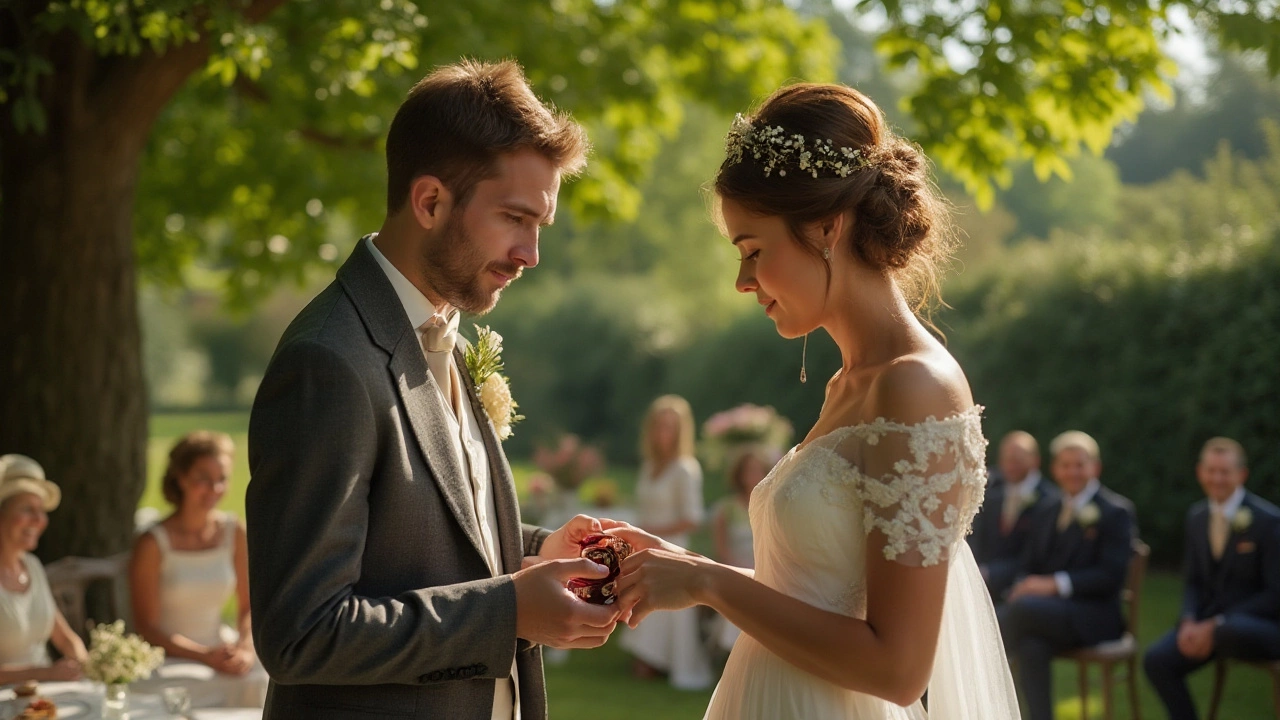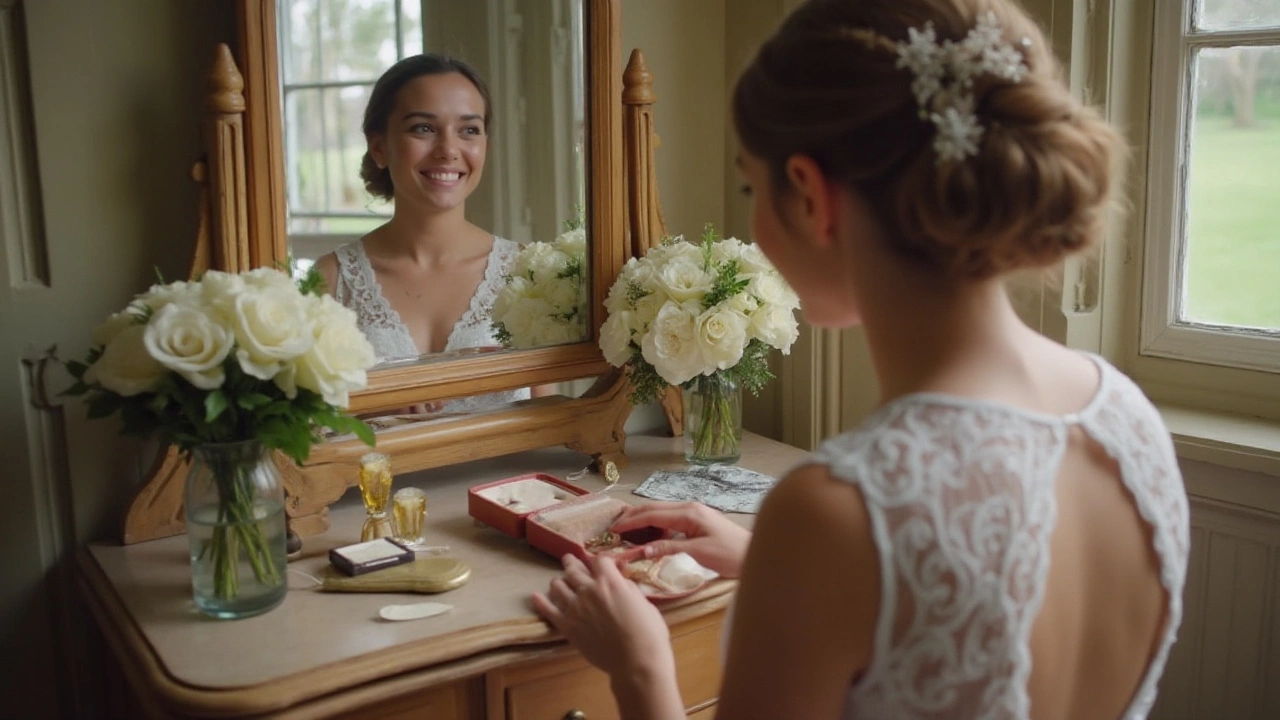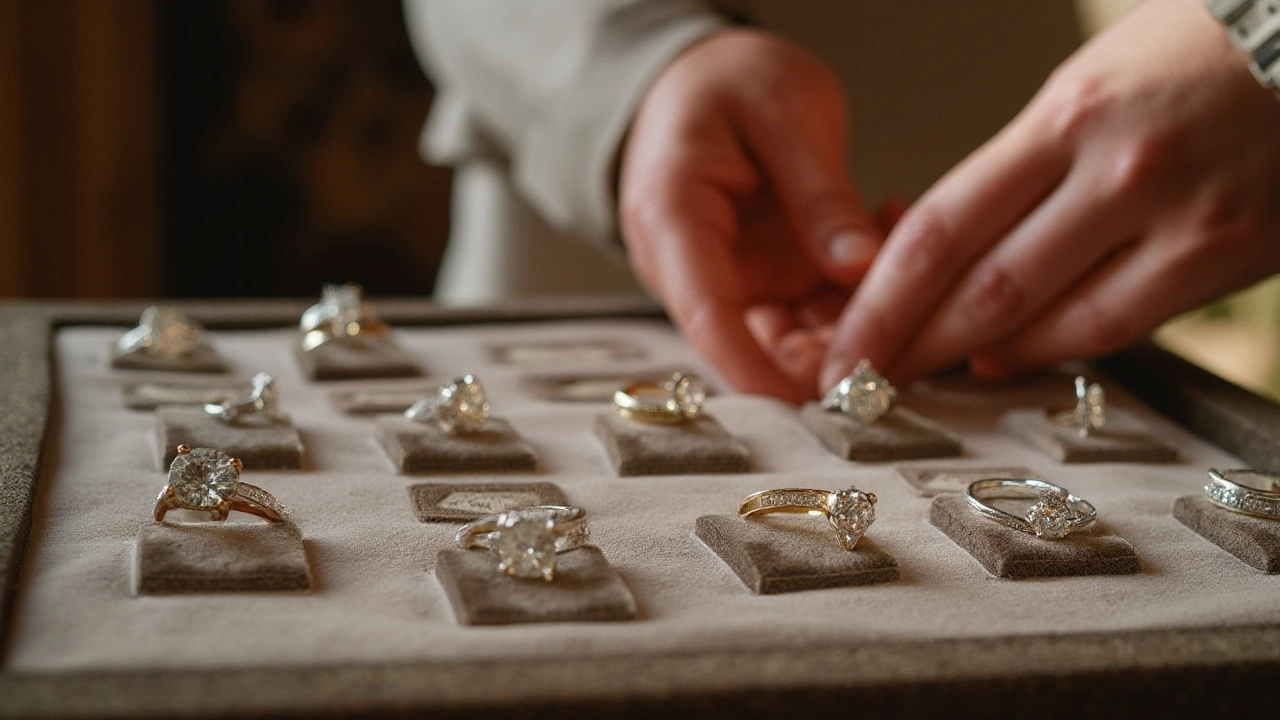The Tradition of Removing Engagement Rings during Marriage Ceremonies
 Jan, 30 2025
Jan, 30 2025
Many brides today choose to remove their engagement rings during the wedding ceremony, a practice that often intrigues guests and even the couple themselves. This ritual is more than just a charming quirk; it’s steeped in age-old traditions and practical considerations. While the engagement ring is a symbol of promise, the wedding ring represents the fulfillment of that promise, hence some brides prefer an uninterrupted transition between the engagement and wedding bands.
Traditionally, the wedding band is worn closest to the heart, which sometimes necessitates the removal of the engagement ring to achieve this. However, this custom is not solely rooted in symbolism; there are practical reasons, too. Many choose to avoid the risk of the engagement ring getting misplaced or tangled with the wedding band during the ceremony. Understanding these customs can add a layer of meaning to the exchange of rings, and knowing how to manage them can save a lot of potential stress on your wedding day.
- The Origin of the Tradition
- Symbolism in Wedding Customs
- Practical Reasons for Temporary Removal
- Modern Takes on the Tradition
- Caring for Your Rings on the Big Day
The Origin of the Tradition
The practice of removing the engagement ring before the wedding ceremony can be traced back to various cultural and historical roots. In ancient Rome, rings were exchanged as symbols of an eternal bond. However, the more intricate customs surrounding the positioning and movement of rings have evolved over the centuries. The concept that the wedding ring should be worn closest to the heart is a romantic notion that emerged in the Middle Ages, aligning with the belief in the 'vena amoris,' or the 'vein of love,' believed to run directly from the fourth finger to the heart.
This tradition was particularly popular in European cultures, where it was considered a thoughtful way to symbolize the shift from engagement to marriage. Organized societies cherished the symbolism, and thus evolved a practice where the engagement ring briefly took a back seat, allowing the wedding ring to shine in its moment of glory. During these times, jewelry also served as more than just decorative pieces. They functioned as personal charms or talismans believed to protect and sustain love. An often-cited historical record from medieval England details how brides would remove their engagement rings during the ceremony to prevent tarnishing the purity of the unbroken circle of their newly bestowed wedding bands.
"Traditions across cultures often carry deeper meanings than just their visible actions. Whether for practical, symbolic or superstitious reasons, the act of removing the engagement ring has layers of history behind it," notes cultural historian Dr. Evelyn Keats.
Transitioning into modern times, the tradition has been kept alive, although practices vary widely based on personal preferences and cultural background. A fascinating observation is how this practice has been embraced in some regions while being overlooked in others. For instance, many North American brides may choose to keep both rings together, symbolizing the continuity of their relationship, even if the custom traditionally suggests otherwise. Despite the regional differences in customs, the essence of the tradition remains—a delicate dance of love, dedication, and promise. Focusing on these aspects not only personalizes ceremonies but also adds a profound level of depth and continuity to the ritual of exchanging rings.
Symbolism in Wedding Customs
Across cultures and centuries, the act of exchanging rings during a wedding ceremony is steeped in varying layers of symbolism. From ancient Egypt to modern times, rings have universally represented the concept of eternal love, with their unending circular shape embodying infinity and unity. The placement of the wedding ring on the fourth finger of the left hand has its roots in Roman times, where it was believed to house the 'vena amoris,' or vein of love, purportedly leading directly to the heart. By wearing the wedding ring closest to the heart, newlyweds symbolize the deep connection that marriage creates.
Another aspect of ring-related symbolism can be found in the transition from engagement to marriage. The engagement ring announces a promise, a pending union, while the wedding ring represents the culmination of that promise into a lifelong commitment. This layered meaning is honored during the ceremony when brides choose to remove the engagement ring to place the wedding band first. It’s a symbolic act of prioritizing the sanctity and importance of the marriage itself over the engagement period that preceded it. This doesn’t diminish the significance of an engagement; rather, it seeks to celebrate the new chapter the couple is embarking on.
Moreover, wedding rituals are often imbued with cultural nuances, which may include the placement and swapping of rings. In some traditions, wedding rings might even be worn on the right hand, symbolizing strength and resourcefulness. In Jewish ceremonies, for instance, the ring is placed on the index finger during the vows as a sign of direct intent, and only later moved to a different finger. Each culture enriches the diamond circle of marriage with its distinct customs and beliefs, creating a tapestry of symbolism that resonates uniquely with each couple.
"A wedding ring is not just metal; it is the story of unity, fashioned by culture, tradition, and the unyielding vows between two people." – Tradition Expert, Alexandra Hartwick
In a contemporary twist, many couples today see these formal customs, like the exchange and placement of rings, as an opportunity to express personal style and affection. Personalizing how they wear and show their rings, couples continue to reinvent traditions to fit their love story best. For instance, some integrate heirlooms, carving initials, or choosing unique, custom designs that reflect shared passions or experiences, thus keeping the tradition alive while honoring individuality.

Practical Reasons for Temporary Removal
When it comes to the wedding ceremony, many brides find themselves contemplating the removal of their precious engagement ring for reasons that extend beyond mere tradition. One of the most prominent considerations is the fitting and placement of the wedding band itself. Since tradition often prescribes that the wedding band should sit closest to the heart, below the engagement ring, temporarily removing the latter ensures a smooth and graceful transition without any awkward maneuvering at the altar.
This practice also aids in avoiding the ceremony mishap — an engagement ring slipping off amidst the vows or during the ring exchange. Imagine the horror of such an incident in the midst of an emotional, once-in-a-lifetime moment! By storing the engagement ring securely, brides can ensure that their rings are snugly replaced atop the wedding band once the formalities conclude, allowing for a picture-perfect fit. In addition, some brides prefer not to distract from the moment of receiving the wedding ring, finding that less is more during the intimate exchange of lifelong promises.
It's important to also consider the metal composition of the bands which can play a significant role in deciding whether to wear both rings concurrently during the ceremony. Different metals react in unique ways when worn together, sometimes leading to scratches or tarnishes that can blemish their appearance. Couples should take into account the durability and hardness of these materials. For instance, a platinum engagement ring combined with a more delicate gold wedding band might unintentionally cause wear.
"Even minor abrasions can accumulate over the years, deteriorating the look and feel of your cherished jewelry," mentions expert jeweler Daniella Ciarfella in her insightful guide on wedding band upkeep.
In terms of comfort, the sheer weight and bulk of wearing an engagement ring with an equally stunning wedding band might be something to ponder. Many brides find that wearing both rings on a particularly adventurous wedding day doesn’t exactly lend itself to easy mobility or comfort. The temporary removal not only ensures protection but can prove somewhat liberating, freeing brides from any cumbersome feelings during the celebration. This factor, often overlooked, can make a world of difference when it comes to enjoying the day unburdened by the thought of managing how rings feel on their finger.
From a logistical standpoint, the ceremony itself often necessitates meticulous planning and organization. Brides usually have plenty to worry about, and the risk of losing or misplacing an engagement ring during signature moments can lead to unnecessary anxiety. Placing the engagement ring in a designated, safe spot helps in keeping not only the jewelry intact but also the bride's state of mind. After all, being assured of the safety of a highly valuable ring allows the focus to remain on what truly matters — the momentous occasion of exchanging vows.
A practical yet oft-overlooked reason involves the aesthetics of wedding photographs. With only the wedding band gracing the bride’s finger, photographers can emphasize the purity and significance of the newly exchanged vow. Additionally, artistic shots of the engagement ring alongside the wedding band after the ceremony often provide stunning and symbolically rich images that capture the beauty of both pieces in a harmonious ensemble.
Modern Takes on the Tradition
Today's couples approach many wedding traditions with a mix of reverence and personal flair, and the case of removing the engagement ring during the ceremony is no different. While some brides adhere to the traditional practice of wearing the wedding ring first to keep it closest to the heart, others are choosing creative ways to integrate their engagement ring styles into the ceremony itself. For many modern brides, the act of removing and then replacing rings can feel antiquated, leading them to explore options like melding the two rings into a single piece of custom jewelry, reflecting the unity of marriage itself.
In recent years, there's been a trend where couples choose to forgo the traditional order entirely, embracing new norms that suit their personal tastes. Its increasing popularity is underscored by the practical convenience it offers. Instead of worrying about potential risks like losing the engagement ring or having two rings feel cumbersome, some brides opt to wear a larger, singular band that symbolizes both engagement and matrimony. However, these decisions aren't solely about convenience; they reflect a broader cultural shift towards personalization in weddings.
Symbolic Innovations
The shift in practice brings with it new symbolic interpretations. While the heart remains central to wedding traditions, modern couples relish the opportunity to inject personal narratives into their ceremonies. For instance, some couples choose bands encrusted with gemstones of personal significance or even engravings that capture an inside joke or shared moment. By blending old traditions with contemporary personal touches, they create a ceremony that's deeply meaningful beyond the standard customs."Today, customization is king in matrimonial rituals," says Lindsey Trent, editor at Bridal Compass Magazine. "Couples aren't just following traditions; they're redefining them to tell their own stories."
This trend is not without its economic implications, indicating a shift towards higher-end, bespoke jewelry that often combines elements of both wedding bands and engagement rings into one unique design. Such decisions often reflect a deeper philosophy about marriage — that it's a union that evolves and melds two lives into a cohesive unit, much like the jewelry signifies.
The modern take on this tradition also aligns with broader societal trends that value simplification and minimalism. The reduced clutter of wearing a single ring often appeals to those committed to sustainable living and minimalism in lifestyle. A single, distinguished piece might feel both stylish and practical, resonating with individuals who appreciate quality over quantity in every aspect of life.
Embracing Change
The diverse approaches to the engagement ring tradition also highlight an increasing embrace of individual expression over rigid adherence to customs. It's a fascinating example of how people today are finding a balance between honoring their heritage and expressing their identities, underscoring the evolving nature of marriage itself. Whether choosing unique materials, exploring new ring orders, or blending traditional with contemporary, today's couples are crafting celebrations reflecting their shared journey and values.

Caring for Your Rings on the Big Day
Your wedding day is a momentous occasion, and ensuring the safety and pristine condition of your engagement ring and wedding bands should be part of your plans. While the ceremony may last only a few hours, the rings are eternal symbols of your vows. It is essential to plan how to handle your precious pieces to prevent any mishaps. Many brides worry about the rings getting lost, scratched, or even ceremonially jumbled. By taking some careful steps ahead of time, you can focus on enjoying your special day, knowing that your rings will be safe and secure.
Start by deciding where you will keep your rings when they're not on your finger. Some brides opt to wear the engagement ring on their right hand temporarily, avoiding any last-minute fumbling during the exchange of vows. Others choose to hand the ring to a trusted friend or family member who will safeguard it. Whatever you decide, make sure that the location or person is secure and dependable. Labeling a small pouch or box with your name and the word 'engagement' is a simple way to differentiate between the two when it's time to return the ring to your left hand.
Another concern is ensuring that your rings remain in perfect condition, free from scratches or damage that can occur during the hustle and bustle of the day. A professional cleaning and inspection the week before the wedding can reveal any loose prongs or other issues that could cause trouble during the ceremony. Consider a jeweler who offers same-day service or speak to your regular jeweler well in advance to schedule an appointment. After all, there's nothing quite like the sparkle of a freshly cleaned diamond as you walk down the aisle.
If you're planning an outdoor wedding, especially one involving sand or grass, there is an added layer of consideration for ring protection. During beach weddings, rings can slip off and instantly disappear in the sand. Intending-on-saying-your-I-do's-in-a-park gatherings might invite rings to take adventurous rolls down grassy hills. To combat such problems, remember to keep your hands dry and free of lotions on the day of the ceremony. If necessary, appoint a friend to remind you, because it's amazing how small details can slip your mind in a whirlwind of excitement! As an extra preventive measure, think about asking your officiant beforehand for ideas on secure ring handling during the ceremony.
And then there's always the sentiment behind keeping your rings safe: these aren't just pieces of jewelry, but cherished keepsakes holding profound meaning. As Laurence Graff once said about the symbolism of rings,
"A ring is not just a piece of jewelry, it is a memory, a story, a symbol of eternal love."Keeping this in mind, every step taken to protect and cherish your rings will be well worth the effort for they are tokens of a day that mark the beginning of a lifelong journey together.